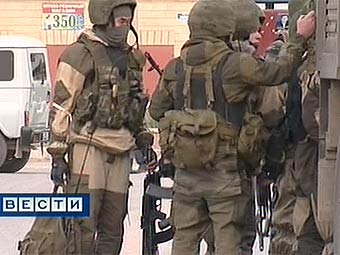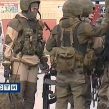
Wave of Unrest and Counter-Terrorist Operations Sweep the North Caucasus
Publication: North Caucasus Weekly Volume: 10 Issue: 8
By:

Russia’s special services and police this past week resumed anti-terrorist operations against the members of the armed resistance movement across the North Caucasus. A steady stream of news has been pouring in from Dagestan that the law enforcement authorities there have been striking back against the republic’s Sharia Jamaat. On February 21, three special operations to neutralize members of the armed resistance movement were carried out in Makhachkala, Dagestan’s capital. Russian sources report that during these operations, three jamaat members were killed and three captured (www.echo.msk.ru/news/574220-echo.html).
The first operation was conducted in the Alburikent settlement on the outskirts of Makhachkala from 8:00 a.m. to noon, and over its course, one militant was killed and three taken captive. That afternoon, a group consisting of three militants was trapped in house No.14A on Tchaikovsky Street and then killed. Although the official mass media, using information provided by the Federal Security Service (FSB) directorate for Dagestan, asserted that there were no casualties among the law enforcers, RIA Novosti cited statements by Dagestan’s Interior Ministry that three police officers were wounded (https://lenta.ru/news/2009/02/21/oper/). This discrepancy suggests that on occasion each agency involved in special operations functions autonomously from the others, including the interior ministry, the FSB and the defense ministry. Finally, the third operation, which took place in another part of Makhachkala—on Engels Street—was finished before dawn. Here, two militants allegedly barricaded themselves in one of the apartments located in a five-story residential building (https://newsru.com/russia/21feb2009/dagest.html). When the law enforcement authorities stormed the building on the morning of February 22, one militant was killed and a woman, who was in the apartment, was detained. Thus, the aggregate result of the 24-hour operation was five militants dead and four captured.
News from Ingushetia about armed assaults on police officers and military has already become everyday reality. In Chechnya, two police officers were killed and two wounded in Urus-Martan. In Kabardino-Balkaria, seven members of the Yarmuk Jamaat were killed on February 11 (www.caucasustimes.com/article.asp?id=19252), and ten days later, on February 21, the militants retaliated by killing an investigator with the police department in the town of Tyrnyauz. In Ossetia, the Kataib al-Khoul Jamaat claimed responsibility for assassinating Vitaly Karaev, the head of administration for Vladikavkaz, the capital of North Ossetia-Alania, who was killed on November 26, 2008 (www.kavkaz.tv/russ/content/2009/02/08/63872.shtml).
Against the backdrop of these alarming and gloomy reports, the police in the entire region of the North Caucasus have been put on alert (Interfax, February 21). The acting head of the main directorate of the federal Interior Ministry for the Southern Federal District, Mikhail Shepilov, informed journalists about this measure at a press briefing held in Rostov-on-Don. “The situation in the south of Russia is constantly complex,” Shepilov said. “Taking into account the impending holidays, the entire personnel of law enforcement bodies have been put on an enhanced variant of service … Operations are planned to counteract illegal armed formations in several regions in the country’s south” (www.interfax.ru/society/news.asp?id=64694). Thus, the authorities have been forced to acknowledge that the situation is far from the ideal picture that the Kremlin image makers have been trying to present to the rest of the world.
According to the commander of the Operational Group of Forces in the North Caucasus, Major General Nikolai Sivak, a total of 79 special operations were carried out against the armed resistance in the region in the month of January alone (www.yuga.ru/news/146393). At the same time, it should be noted that the absolute majority of these special operations took place in Chechnya (Novosti TV [Grozny], February 16). This is surprising because, compared to Dagestan and Ingushetia, there has been very little information coming out of Chechnya lately. This can be attributed to the fact that Chechnya is still closed and the authorities there do not allow journalists unfettered access. Evidently the large-scale operations against the militants and the retaliation by militants against law enforcement authorities in Chechnya at present remain largely beyond the media’s radar, which makes it difficult to follow the situation in the republic as it evolves.
The resumption of operations by the police and FSB forces became noticeable after the public admission by Russian President Dmitry Medvedev that crimes of an extremist nature had begun to increase across the country. According to Medvedev, such crimes represent a systemic threat to national security and are “capable of destroying any society” (https://echo.msk.ru/news/570887-echo.html). Supplementary special operations detachments will be created within the structure of the federal Interior Ministry to fight against this threat, which may imply a new redistribution of spheres of influence between the Interior Ministry and the FSB in favor of the former. Earlier, during an expanded meeting of FSB officials on January 29, Medvedev was forced to note that the situation in the North Caucasus region “remains complex” and demanded “to seriously increase the coordination of work of all law enforcement agencies” (www.regnum.ru/news/fd-south/chechnya/1117601.html).
The Russian authorities simply can no longer hide the fact from the public that not all is well in the North Caucasus, and another confirmation of this was Moscow’s decision to categorize all means of transportation arriving from the national republics of the North Caucasus as potentially dangerous. This means that all transportation units must be submitted to mandatory inspection of cargo and passengers upon its arrival in Moscow. The first deputy chief of the Moscow Interior Ministry directorate for air and water transportation, Viktor Ivashchenko, stated that “such procedures are carried out with the purpose of preventing the accumulation of weapons, munitions and narcotics in the Moscow region, as well as for the identification of persons who intend to carry out terrorist acts and actions of an extremist nature” (Interfax, January 21). In other words, while only residents of Chechnya were subjected to such actions in the past, now they are also directed toward the residents of Dagestan, Ingushetia, Kabardino-Balkaria, Karachaevo-Cherkessia and Adygea. This means that the Russian establishment is forced to admit that nine years after the beginning of the war in Chechnya, the North Caucasus region is far less secure and, on the contrary, there is an urgent need to toughen the inspection of everyone who arrives from a region of the country as undoubtedly unreliable as southern Russia.
The top priority for the National Anti-Terrorist Committee (NAC) this year is to guarantee constant and reliable control over the development of the situation in the North Caucasus and to exert a preventive positive influence on it, according to the NAC chairman, FSB Director Aleksandr Bortnikov (https://www.rosbalt.ru/2009/02/10/616999.html). This means that all power structures must deal with the reality that the situation is not only dangerous, but that it can escalate to a level that may involve large-scale attacks on law enforcement authorities and state representatives in different locales.
The admission at such a high level that the situation is dangerous for the country as a whole is evidence that the policy of terror toward the local population has failed. In other words, punitive actions based on the principle of collective responsibility (like those employed in Chechnya) have proved to be futile. The tactics have changed and the focus is now on playing up the nationality card. There are signs of a shift from emphasizing the religious differences to using ethnic divisions. The Ossetian-Ingush conflict is a case in point, a number of unusual steps have been taken lately toward resuming the dialogue between these ethnicities. In the North Caucasus, where there are many competing territorial claims, use of this factor could prove to be far more dangerous than the familiar gambit of playing the religious card (the standoff between the Salafists and Sufis). This initiative may backfire on the Kremlin, and Moscow may fall into the trap that it has set for the national minorities.
Moscow continues to suffer from the lack of a long-term policy vis-à-vis the North Caucasus, which is vividly seen in the clashes between different power structures in various locales of the region, as well as on the federal level.




